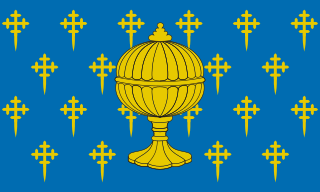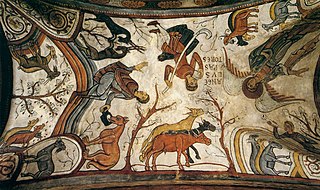Related Research Articles

James the Great was one of the Twelve Apostles of Jesus. According to the New Testament, he was the second of the apostles to die, and the first to be martyred. Saint James is the patron saint of Spain and, according to tradition, his remains are held in Santiago de Compostela in Galicia.
The Historia Compostelana is a historical chronicle by several authors based on the relation of events by a writer in the immediate circle of Diego Gelmírez, second bishop (1100–1120) then first archbishop (1120–1140) of Compostela, one of the major figures of the Middle Ages in Galicia. The primary narrative of the Historia Compostelana spans the years 1100 – 1139, the years of Gelmírez' tenure, in three books. Its twofold central agenda is to extol the Archbishop's doings, while establishing the foundation and rights of Santiago de Compostela, including its founding legend, which provided apostolic connections with Saint James the Great. The bishopric had been transferred from Iria Flavia to Compostela as recently as 1095.
Iria Flavia or simply Iria in Galicia, northwestern Spain, is an ancient settlement and former bishopric in the modern municipality of Padrón, which remains a Catholic titular see.

The Kingdom of Galicia was a political entity located in southwestern Europe, which at its territorial zenith occupied the entire northwest of the Iberian Peninsula. It was founded by the Suebic king Hermeric in 409, with its capital established in Braga. It was the first kingdom that officially adopted Catholicism. In 449, it minted its own currency. In 585, it became a part of the Visigothic Kingdom. In the 8th century, Galicia became a part of the newly founded Christian Kingdom of Asturias, which later became the Kingdom of León, while occasionally achieving independence under the authority of its own kings. Compostela became the capital of Galicia in the 11th century, while the independence of Portugal (1128) determined its southern boundary. The accession of Castilian King Ferdinand III to the Leonese kingdom in 1230 brought Galicia under the control of the Crown of Castile.

BermudoII, called the Gouty, was first a rival king in Galicia (982–984) and then king of the entire Kingdom of León (984–999). His reign is summed up by Justo Pérez de Urbel's description of him as "the poor king tormented in life by the sword of Almanzor and in death by the vengeful pen of a bishop," Pelagius of Oviedo, half of whose Chronicon covers the reign of Bermudo and is highly critical of the king. He accuses Bermudo of imprisoning Bishop Gudesteus of Oviedo in the 990s and blames the attacks of Almanzor on Bermudo's sins.

The Historia Caroli Magni, also known as the Historia Karoli Magni et Rotholandi or the (Pseudo-)Turpin Chronicle, is a 12th-century Latin chronicle consisting of legendary material about Charlemagne's campaigns in Spain. The chronicle states it was written by Charlemagne's contemporary Turpin, Archbishop of Reims, but it was found out as a medieval forgery. The work was extremely popular, and served as a major source of material on Charlemagne in chronicles, fiction and iconography throughout Medieval Europe. The miracles of the flowering lances and the death of Ferracutus appear on the windows of Chartres cathedral.

The Diocese of Tui-Vigo is a Latin Church ecclesiastical territory or diocese of the Catholic Church in Northwestern Spain. It is a suffragan diocese in the ecclesiastical province of the metropolitan Archdiocese of Santiago de Compostela.

The Diocese of León is a Latin Church diocese of the Catholic Church located in the city of León in the ecclesiastical province of Oviedo in Spain.
The Annales Compostellani or Anales castellanos terceros are a set of Latin annals found in, and named after, Santiago de Compostela. They were found in the manuscript known as the Tumbo negrode Santiago de Compostela, but they were originally redacted in the Rioja. They are grouped with the Chronicon Ambrosianum and the Chronicon Burgense as the Efemérides riojanas. They cover the history of the County and Kingdom of Castile and the Kingdom of Navarre until the reconquest of Seville in 1248.
Pelayo Rodríguez was the Bishop of Iria Flavia (977–985). He was a son of the powerful magnate Rodrigo Velázquez and his wife Adosinda and is usually associated with the conflicts surrounding the accession of Vermudo II after a Galician rebellion in 982.
Rodrigo Velázquez was an important magnate of Galicia during the reigns of Ramiro II, Ordoño III, Sancho I, and Ramiro III. He used the title dux (duke), the highest in Galicia at the time, and he even treated diplomatically with the Caliphate of Córdoba. He has been implicated in factional fighting over the succession to the Leonese throne, but the major battle of his career was part of a private aristocratic feud.
Gonzalo Menéndez was a Count of Portugal in the Kingdom of León. He regularly carries the title count (comes), the highest in the kingdom, in surviving documents. He may have used the title magnus dux portucalensium. His name in contemporary records is usually spelled Gundisaluus Menendiz.

The Historia silense, also called the Chronica silense or Historia seminense, and more properly Historia legionense, is a medieval Latin narrative history of the Iberian Peninsula from the time of the Visigoths (409–711) to the first years of the reign of Alfonso VI of León and Castile (1065–1073). Though originally intended as a gesta of Alfonso, it is primarily an original account of the reign of his father, Ferdinand I (1037–1065). For its earlier history it relies on the works of Isidore of Seville, Julian of Toledo, and the Vitas sanctorum patrum Emeritensium for the Visigothic period, the Chronicle of Alfonso III for the ninth century, the work of Sampiro for the tenth and early eleventh centuries, and the Chronicon of Pelayo of Oviedo for the eleventh century. The Historia along with Pelayo's Chronicon provide the only surviving versions of Sampiro's otherwise lost history.
Hermenegild II was an auxiliary bishop or coadjutor of the Diocese of Oviedo during the episcopates of Gomelo II, Flacinus, and Oveco. He was long mistaken for a senior bishop, as by Carlos González de Posada, who interposed his episcopate in that of Oveco for the years 915–22, and Manuel Risco, who placed it in 921–26.

Pelagiusof Oviedo was a medieval ecclesiastic, historian, and forger who served the Diocese of Oviedo as an auxiliary bishop from 1098 and as bishop from 1102 until his deposition in 1130 and again from 1142 to 1143. He was an active and independent-minded prelate, who zealously defended the privileges and prestige of his diocese. During his episcopal tenure he oversaw the most productive scriptorium in Spain, which produced the vast Corpus Pelagianum, to which Pelagius contributed his own Chronicon regum Legionensium. His work as a historian is generally reliable, but for the forged, interpolated, and otherwise skilfully altered documents that emanated from his office he has been called el Fabulador and the "prince of falsifiers". It has been suggested that a monument be built in his honour in Oviedo.

Pedro Fróilaz de Traba was the most powerful secular magnate in the Kingdom of Galicia during the first quarter of the twelfth century. According to the Historia compostelana, he was "spirited ... warlike ... of great power ... a man who feared God and hated iniquity," for Diego Gelmírez himself had "fed him, like a spiritual son, with the nutriment of holy teaching." Brought up at the court of the Emperor Alfonso VI, Pedro raised the future Emperor Alfonso VII in his household. Around the latter he and Diego formed a "Galician party" that dominated that region during the turbulent reign of Urraca (1109–26). In September 1111 they even had the child Alfonso crowned king at Santiago de Compostela, but it was Pedro who was imperator in orbe Galletiae.
Menendo González was a semi-autonomous Duke of Galicia and Count of Portugal (997–1008), a dominant figure in the Kingdom of León. He was the royal alférez, the king's armour-bearer and commander of the royal armies, under Vermudo II, and he continued to hold the position until his death. He became the tutor (1003) and ultimately father-in-law of Vermudo's successor, King Alfonso V. He maintained peaceful diplomatic relations with the Caliphate of Córdoba until 1004, after which there was a state of war.

The Spanish Episcopal Conference is an administrative institution composed of all the bishops of the dioceses of Spain and Andorra, in communion with the Roman Pontiff and under his authority. Its purpose is the joint exercise certain pastoral functions of the episcopate on the faithful of their territory, under common law and statutes, in order to promote the life of the Church, to strengthen its mission of evangelization and respond more effectively to the greater good that the Church should seek to men.
Pelayo Menéndez was the bishop of Tui (Túy) from 1131 until his death. He was the fourth bishop after the restoration of the diocese (1070), which had fallen into abeyance in the tenth century as a result of Viking and Moorish raids.
Pelayo Curvo was a Galician nobleman active between 1128 and 1173.
References
- Barton Sholod. 1966. Charlemagne in Spain: The Cultural Legacy of Roncesvalles (Geneva: Librairie Droz), p. 129.
- José-Luis Martín. 1965. "Pelayo Rodríguez, obispo de Santiago (977–985)", Anuario de los estudios medievales, 2, 474.